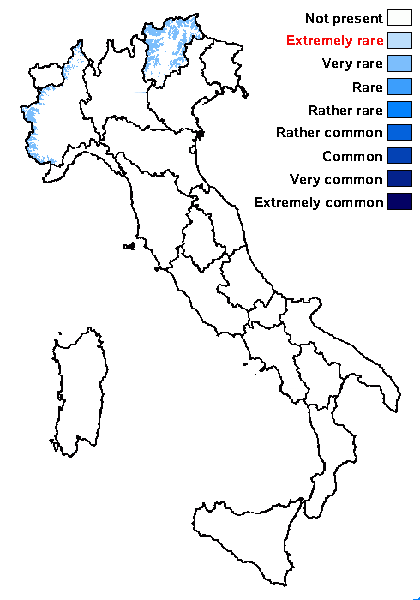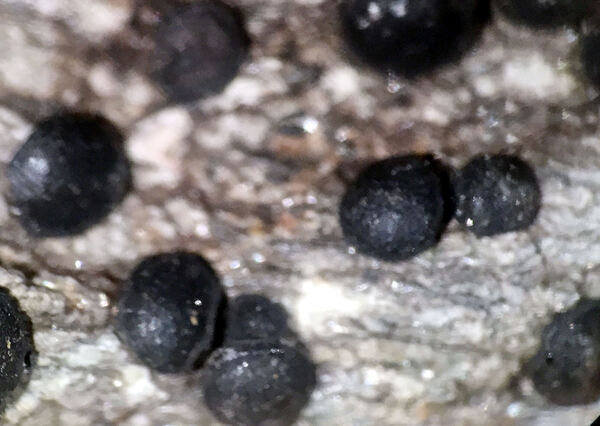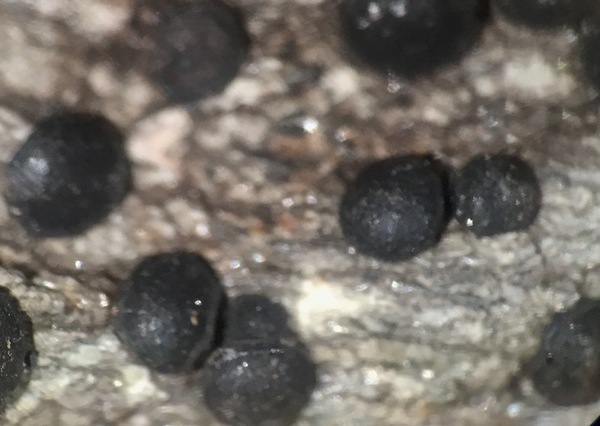Porpidia superba (Körb.) Hertel & Knoph
in Hertel, Beih. Nova Hedwigia, 79: 438, 1984. Basionym: Lecidea superba Körb. - Syst. Lich. Germ.: 248, 1855.
Synonyms: Huilia superba (Körb.) Hertel; Lecidea incrassata H. Magn.; Lecidea macrocarpa var. superba (Körb.) Th. Fr.
Distribution: N - TAA (Nascimbene & al. 2022), Piem (Isocrono & al. 2004).
Description: Thallus crustose, episubstratic, bullate-areolate, the areoles usually convex, often well-separated from each other, chalky white, more rarely creamy white or very pale grey, scabrid, rarely delimited by a black prothallus. Medulla white, I-. Apothecia lecideine, at first immersed at margins of areoles, later sessile, 0.5-1.5(-2) mm across, with a brown to black-brown, sometimes (especially when young) white-pruinose, flat to finally slightly convex disc, and an epruinose, rather thick, undulate, black proper margin; wet apothecia turning red-brown. Proper exciple thick, dark brown throughout (a paler inner area visible on very thin sections only), of radiating hyphae; epithecium brownish to orange-brown, c. 20 µm high, N+ orange, K-; hymenium colourless, 90-150 μm high; paraphyses strongly coherent, branched in upper part and richly anastomosing, 1.5-2 µm thick at mid-level, the apical cell to 4 µm wide; hypothecium thick, brown-black. Asci 8-spored, elongate-clavate, with a thin, outer amyloid layer and a thickened tholus penetrated by a pore, the sides of which stain I/KI+ deep blue, Porpidia-type. Ascospores 1-celled, hyaline, ellipsoid to ovoid, (16-)19-28(-33) x (6-)8-12(-14) μm, thin-walled, halonate when young. Photobiont chlorococcoid. Spot tests: thallus K-, C-, KC-, P-; medulla sometimes K+ yellow, P+ orange-yellow. Chemistry: no lichen substances, or medulla with stictic acid (usually traces).Note: a mainly arctic-alpine lichen found on weakly calciferous or basic siliceous rocks in sheltered situations near or above treeline. An earlier record from Emilia (see Nimis 1993: 570), being dubious, is not accepted here.
Growth form: Crustose
Substrata: rocks
Photobiont: green algae other than Trentepohlia
Reproductive strategy: mainly sexual
Commonnes-rarity: (info)
Alpine belt: very rare
Subalpine belt: very rare
Oromediterranean belt: absent
Montane belt: absent
Submediterranean belt: absent
Padanian area: absent
Humid submediterranean belt: absent
Humid mediterranean belt: absent
Dry mediterranean belt: absent

Predictive model
Herbarium samples
Growth form: Crustose
Substrata: rocks
Photobiont: green algae other than Trentepohlia
Reproductive strategy: mainly sexual
Commonnes-rarity: (info)
Alpine belt: very rare
Subalpine belt: very rare
Oromediterranean belt: absent
Montane belt: absent
Submediterranean belt: absent
Padanian area: absent
Humid submediterranean belt: absent
Humid mediterranean belt: absent
Dry mediterranean belt: absent

Predictive model
| Herbarium samples |
 Index Fungorum
Index Fungorum
 GBIF
GBIF




